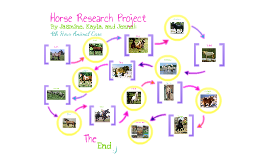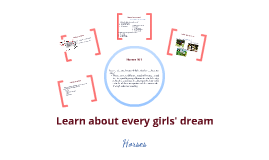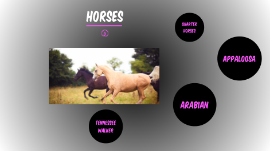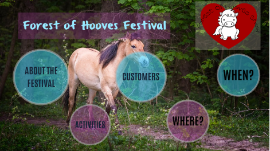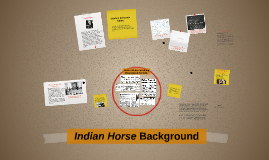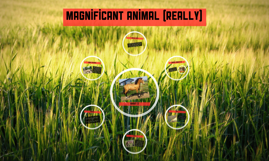Horse Presentation
Transcript: horse: 1.) a large, solid-hoofed, herbivorous quadruped, Equus caballus, domesticated since prehistoric times, bred in a number of varieties, and used for carrying or pulling loads, for riding, and for racing. 2.) any of several odd-toed ungulates belonging to the family Equidae, including the horse, zebra, donkey, and ass, having a thick, flat coat with a narrow mane along the back of the neck and bearing the weight on only one functioning digit, the third, which is widened into a round or spade-shaped hoof. research: 1.) diligent and systematic inquiry or investigation into a subject in order to discover or revise facts, theories, applications, etc. 2.) to make an extensive investigation into 3.) to learn about something you don't know about by looking up information on multiple sources project: 1.) a specific task of investigation, especially in school 2.) a supplementary, long-term educational assignment necessitating personal initiative, undertaken by an individual student or a group of students. The Auxios originated in France, and was originally used for its meat. The Auxois is a kind, quiet, and has a good temperament. The Auxois stands about 16.3 hands, and is a dull, caramel color. They have extremely powerful legs, and run very fast. These horses consume a massive amount of food, and are only found in their country of origin, France. These horses originated in Turkmenistan. These ancient horses can withstand the rigid high temperatures of the desert. They can be bay, black, chestnut, and gray. They stand 14.2 to 15.2 hands high. These endangered horses are very versatile, and are not found in the US. Originated in Arabia. Used for farming, carriages, labor, and as pets. They can be chestnut or bay. These horses are found in the US. Stand between 14.2 to 15.2 hands. These horses are commonly used to do the work a mule would regularly do. They can be bay. Originated in Italy, and are only found there. Can be 13 to 14 hands. Can be black, brown, and tan. Used for farming and agricultural purposes. These are not found in the US. Can be 12 to 14 hands. These horses originated from Carmague, France. They're used for many things: -Mount of guards -Livestock management -Long distance riding These horses stand from 13.1 to 14.3 hands high, and weigh anywhere from 770-1,100 pounds. They have a short neck, deep chest, compact body, good joints, strong limbs, and a full mane and tail. They can be found in the US. These horses are native to the Siberian Sakha Republic. Used in some places for the mare's milk. They are a small breed of about 14.3 hands high. They are known for their thick hair, coat, and mane. They are usually grey, with prime markings such as a dark stripe on the back, and zebra-like stripes on legs. They're not found in the US. These horses hail from the Basque Country in France and Spain. These horses used to be used for circuses, but are now used for children's ponies because of their size and their domestication adaptability. These horses stand from 11.1 to 14.2 hands, and weigh between 661 to 772 pounds. They are usually brown, black, or bay colored. They have a large, square head, small ears, short neck, long back, short legs, and sturdy hooves. They are not found in the US. Native to the Carpathian Mountains. Used for packing and riding. Usually bay, black, chestnut, or dun colored, with stripes on their backs, and also on their legs. They have a short head, short neck, short legs, compact body, and sound feet. Originated in Sudan. They are not found in the US. These horses are found in their country of origin, Japan. They were used for agricultural work, such as cultivating crops, and pulling heavy sleds of wood. Their popularity grew in the 1950s, when they became popular for racing. Their races consisted of the horse pulling a heavy load over hills for 200 meters. Most horses never finished the races. The winner was the one who went the farthest. They are generally a solid black color, but can be chestnut. They are calm, patient, and willing to work. They stand from 14.1 to 16 hands. This horse originated from Spanish horses brought to South America by settlers. They were then brought to the US. They were once used for pulling small stagecoaches in parades, but are now used for children's entertainment. They stand between 2.5 and 4.3 hands high. Although much smaller than horses, they have the same proportions. They also have a small, slim, compact frame, along with a sleek coat. Because of their gentile nature and size, they can be used as guide/assistant animals. They're found in the US. They originated in Turkey in 1854. They stand 14.2 to 16 hands high. They have a distinctive metallic sheen. Common colors are buckskin and palomino. They are used for many things: -dressage -sports -jumping -eventing -racing -endurance riding They are found in the US. Small, pony sized horse found in Iceland. It is, however, classified there as a horse. It is the only breed of horse in Iceland.







